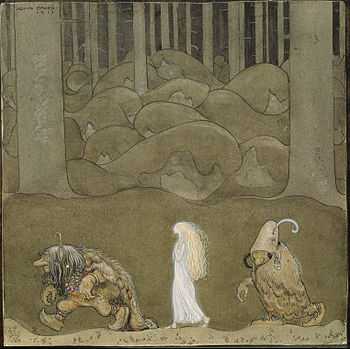Myling
In Scandinavian folklore, Mylings are the phantasmal incarnations of the souls of unbaptized children that had been forced to roam the earth until they could persuade someone (or otherwise cause enough of a ruckus to make their wishes known) to bury them properly.
Lore
The myling (also known as "utburd" or "ihtiriekko" in Finnish) is said to chase lone wanderers at night and jump on their backs, demanding to be carried to the graveyard, so they can rest in hallowed ground. Mylings are thought enormous and apparently grow heavier as they near the graveyard, to the point where any person carrying one (or more) could sink into the soil. If one should prove unable to make it into the cemetery, the myling kills its victim in rage.
History
The word "utburd" means "that which is taken outside" and refers to the practice of abandoning unwanted children (e.g. children born out of wedlock or to parents who lacked the means to care for them) in the woods or in other remote places, where death is almost certain to befall them. It is believed that the ghosts of the child will then haunt the place where they had died or, as told of in countless stories, the dwellings of their killers.
This infanticide is generally carried out secretly and its victims were often abandoned shortly after birth. From the perspective of certain Christian denominations, the babies are thus denied baptism, acceptance into the Church, and proper burial. As such, they cannot rest peacefully.
The belief that Mylings are enraged and seeking revenge is what gave them the reputation as one of the most menacing types of ghosts in Scandinavian folklore.
See also
- Wiedergänger
- Bukavac
- Drekavac
- Konaki-jiji (Japanese "Myling")
References
- ↑ Klintberg, Bengt af (2010). "C. Death and the Dead." The Types of the Swedish Folk Legend. Helsinki: Academia Scientiarum Fennica. p81-85.
- ↑ Kvideland, Reimund and Henning K. Sehmsdorf (1988). Scandinavian Folk Belief and Legend. The Nordic Series, v. 14. Minneapolis: University of Minnesota Press. p113-118.
- ↑ Pentikäinen, Juha (1989). "The Dead Without Status." Nordic Folklore, ed. Kvideland and Sehmsdorf. Bloomington: Indiana University Press. p128-136.
- ↑ Pentikäinen, Juha (1968). The Nordic Dead Child Tradition. Helsinki: Academia Scientiarum Fennica.
- ↑ Simpson, Jacqueline (1988). "The Dead." Scandinavian Folktales. London: Penguin Books. p89.
| ||||||||||||||||
